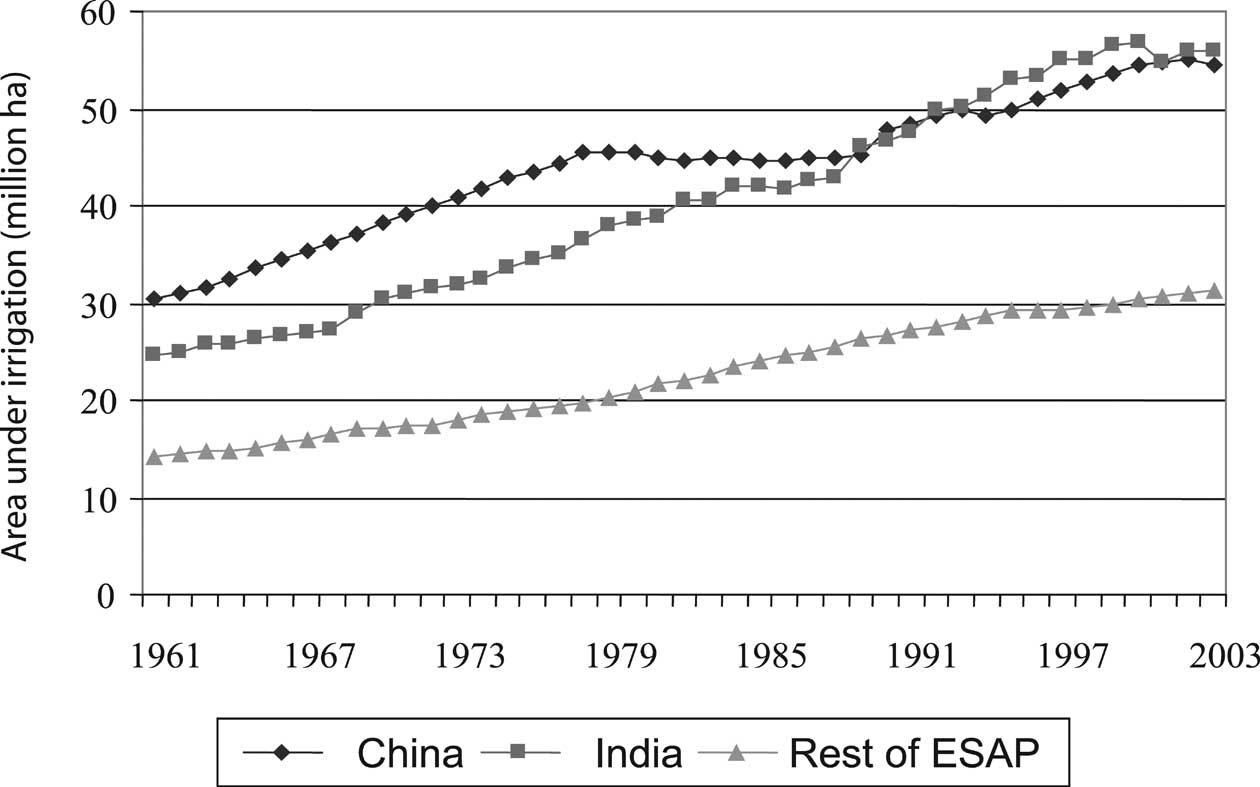The pace of irrigation expansion and the share of irrigated total cropland have varied substantially across countries (Table 2-1). Japan is the only country that has experienced a decline in the amount of irrigated land, brought about by the shrinkage of the paddy rice area, which was nearly halved during 1961-2003 (FAO, 2006a).
Irrigation was important in the Green Revolution in the 1960s through the 1980s. Irrigation is crucial for stable and high yields and for increasing total food production. Crop yield on irrigated land is usually significantly higher than the yield on rainfed land.
Irrigation also enabled more intensive use of land. Double and triple cropping was able to spread to where the rainy season is long enough for only one crop a year. The high yield and increased intensity of land use resulted in a much larger proportion of food production on irrigated land than its share in total cultivated land. For the region as a whole, about 60% of the food production was from irrigated land, which was about 28 % of total cropland. Irrigated areas produced about 70% in China and 50% in India of the total national food production (Lipton and Litchfield, 2003).
Traditionally, surface irrigation was the most widely used in ESAP. However, the past 50 years have seen a rapid expansion of groundwater irrigation. As electricity became more widespread and pumping and well-drilling technology improved, groundwater has become increasingly important, particularly in arid and semiarid areas. By the mid-1990s, half of China's irrigation water came from wells (Brown, 1994). In India, about 60% of the irrigated areas rely on groundwater (IWMI, 2002).
Groundwater is a primary buffer against the vagaries of climate and surface water. Because groundwater for crops can be used on time, it is often more productive than surface water. Some locations in India showed yield on crops irrigated by groundwater 2 to 3 t ha-1 higher than with canal irrigation (Shah et al., 2001; Lipton and Litchfield, 2003).
The proliferation of wells has owed a lot to inexpensive |
|
groundwater technology, such as treadle pumps. Low-cost pumps have helped fuel the groundwater boom, mostly with private investment from farmers. Groundwater is available in groundwater-rich areas to anyone who can afford a pump. It has been a boon to small-scale farmers, even poor ones. In China, the number of groundwater pumps owned per hundred farm households increased from 1.69 to 22.5 between 1985 and 2005 (China, 2006).
In surface irrigation systems, flood irrigation has been dominant in ESAP countries. Its generally low irrigation efficiency leaves ample room for saving water. However, in river basins, the water-saving potential may be lower than anticipated because part of the "lost water" upstream can recharge the groundwater and become available downstream (Molden and Fraiture, 2004). Commonly used water-saving technology included furrow and border irrigation, mulch and terracing. In the Ningxia Autonomous Region in China, official statistics showed that irrigation water withdrawal from the Yellow River decreased from 8.9 to 6.7 billion m3 between 1998 and 2004, while the irrigated area increased from 387,000 to 406,000 ha, mostly by using various water-saving measures.
More advanced irrigation technology, such as sprinkler, microirrigation and laser leveling, was seen in the region, but on a rather small scale. In Japan, sprinkler irrigation and microirrigation were about 9.5% of the total irrigated area in the late 1990s. In India, it was 1.5%. Mongolia was the only country where sprinkler irrigation was significant, as large schemes were equipped with sprinkler irrigation in the 1980s (FAO, 1999). In China, sprinklers, drip irrigation and low pressure pipes were used in about 10% of the total irrigated area in 2004 (China, 2006). In other countries, national data for the application of irrigation techniques were generally not available.
By the mid-1970s, farmers had adopted drip irrigation in some ESAP countries, such as Australia and New Zealand. Drip irrigation is especially effective in arid and |

